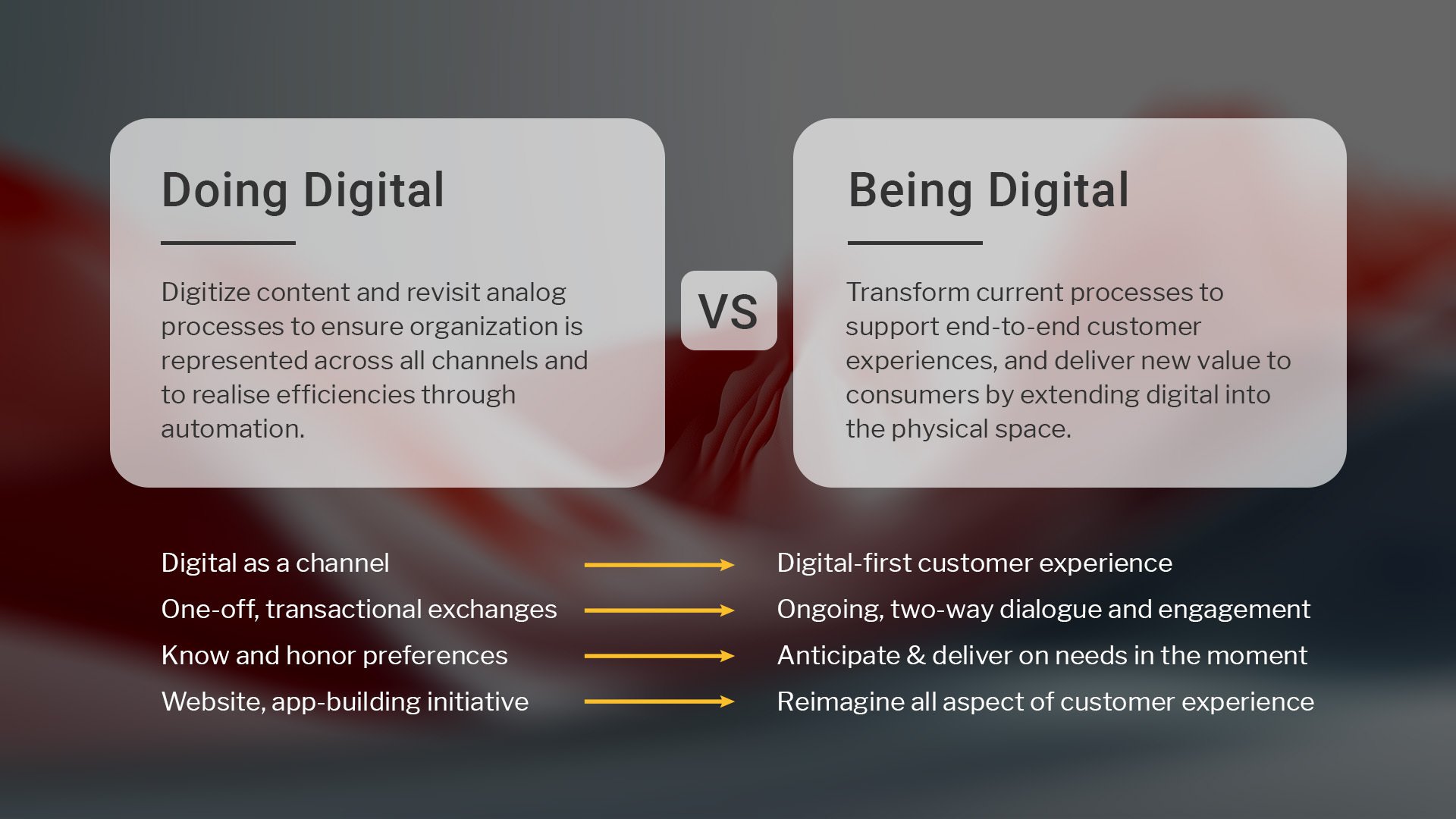Digitalization, digital transformation, and now digital enablement. Few business leaders right now are not confronted with these terms daily—whether in industry articles, external consulting firms, or internal employees. This is especially true in ecommerce, where the race is to meet the continually changing expectations of the customer and where the winners will be those brands that make the transition to truly being digital.
With today’s digital landscape, consumers expect seamless digital experiences throughout their journey with you. Delivering on that often requires a change in technologies, a change in operations, and, most importantly, a change in culture. While “Doing Digital” represents an important step in your transformation, “Being Digital” is crucial to rapidly developing your digital presence and responding to consumer needs.
So what then, is digital enablement?
CONTENT
- Digital enablement: A definition
- The five key steps to digital enablement in an enterprise
- Key takeaways
- How Vaimo can help your digital transformation
Digital enablement: A definition
Digital enablement is one of those terms that gets thrown around a lot these days as companies work hard to accelerate their digital transformation. The term can get diluted in the context of all the other buzzwords, made worse by the many vague definitions found online.
One helpful definition from Insight, describes digital enablement as the process of leveraging digital tools and technologies to optimize business processes, increase operational efficiency, enhance customer experiences, and drive profitability.
If we apply this definition to the enterprise, then we are referring to the action of operationalizing the digital strategy. This means aligning business objectives and roadmaps with the appropriate digital technologies while fostering a culture of collaboration and innovation. For instance, in a retail business, digital enablement could involve integrating an AI-powered customer service chatbot to streamline support and improve response times, or implementing an advanced inventory management system to optimize stock levels and reduce waste.
True digital enablement is not just about deploying technologies—it’s about aligning these tools with operational workflows and fostering a culture that prioritizes seamless customer journeys. This requires deliberate planning and execution.

The five key steps to digital enablement in an enterprise
1. Get buy-in from all stakeholders
It doesn’t matter how many brilliant new platforms and processes a company invests in if, in the end, nobody is using them or if they’re used in the wrong way. It’s the people who drive the success of digital transformation, not technology alone. If stakeholders don’t see the value or feel invested, adoption falters, and the potential of new systems goes unrealized.
Many people are inherently adverse to change, and all change requires some extra effort. This is reflected in the fact that approximately 70% of change initiatives fail, often due to employee resistance and lack of management support. Ignoring these realities often leads to failure midway through transformation efforts.
Getting buy-in beforehand from everyone in the enterprise is essential to ensure the adoption of new technology and business practices. Communicate why the change is necessary—how it supports the company’s strategy, objectives, and individual success. Share a vision of the future state to help stakeholders understand the need and motivation for change.
Creating channels for feedback and reactions is equally essential. People who feel heard are more likely to engage and support the initiative. Feedback can also uncover valuable insights to refine the process, ensuring better adoption and satisfaction.
Build an efficient technology ecosystem optimized for organizational and industry-specific needs. At times a reduction and replacement of current platforms is more beneficial than the blind amassing of technology.
Objectives and key results (OKRs) can come in handy here to establish action-oriented goals and measures tied to the future direction of the enterprise. Make sure goals are ambitious and bold with a set time frame.
2. Make time for a well-planned onboarding process
Onboarding is crucial in the transformation journey and will enable your teams to adopt the platforms and processes fully. Even the most powerful tools may fail to achieve their potential without thorough onboarding. Teams need structured guidance to adapt to the technology and the operational changes that come with it.
Modify the organization’s structure and operations to deliver world-class digital solutions, recruit talent, and build teams to execute against the roadmap while maintaining the ability to rapidly change course in response to shifting consumer and enterprise needs. The composition and structure of resources must align closely with the organization’s stated goals.
Recognize that some employees may feel insecure or resistant to these changes. Address these emotions by demonstrating why the transformation matters and how it helps employees achieve individual and team goals. Communicating the value of these changes ensures the organization moves forward as a cohesive unit.
3. Align the organization around the new processes and goals
One of the key benefits of digital transformation is its potential to break down departmental silos within organizations and provide everyone with shared processes and a shared roadmap. However, alignment doesn’t happen automatically. Collaboration and clarity are essential—without it, inefficiencies, miscommunication, and friction can derail progress.
Take a multi-channel marketing campaign approach; the marketing team is just one of many business areas involved. The analytics team, IT, developers, and compliance may also have critical roles in the initiative. A lean governance or operating model can be helpful in articulating who does what in the different stages of each process.
Clearly defined, measurable goals that are visible across the organization keep teams aligned and focused. Using a framework such as S.M.A.R.T.—which stands for Specific, Measurable, Achievable, Relevant, and Time-bound—ensures that goals are clear, actionable, and realistic. This approach provides a structured way to set objectives, helping teams understand exactly what is expected, how success will be measured, and the timeline for achieving results. Post-launch metrics then offer valuable insights for ongoing optimization, ensuring progress is tracked and opportunities for continuous improvement are uncovered.
Understanding the varying degrees of processes, approvals, or involvement across various stakeholder groups is important. Specifics include defining the different roles across the organization, how they relate to strategic objectives, and documenting their responsibilities. This “operational alignment” is a critical component of digital enablement.
4. Provide the necessary training for everyone involved
As we’ve already mentioned, a shift in mindset is a critical component of digital enablement. However, the ultimate goal is also to upskill the different parts of the organization so that everyone can fully leverage the new technology. This training can be provided through various methods, from intranet to workshops, seminars, ad-hoc support clinics, and sometimes larger-scale programs.
Overall, only about a third of transformations meet or exceed their target value and achieve sustainable change. This highlights the challenges organizations face when digital enablement is not working. Creating training content in multiple formats will help employees adopt and start using new tools and working methods.
Communicate digital best practices as a thought leader throughout the enterprise to establish a culture of innovation across the organization. Driving awareness of the importance of digital to all levels of the organization ensures opportunities are not missed.
5. Create an efficient ongoing communication program
A good communication program will reduce the time and cost required to adopt new platforms, processes, and ways of working. It’s important to remember that not all information is relevant to everyone and avoid information overload. Identify the various stakeholders, their degree of involvement in the new platforms, and the level of detail they each need to be able to use the latest tools.
Setting up the communication structure and planning ahead will significantly improve the success of your program. Make an inventory of the material you need, such as weekly newsletters, dashboards, demo videos, and other methods for keeping everything on track. Models like A.D.K.A.R (Awareness, Desire, Knowledge, Ability, and Reinforcement) can effectively orchestrate change programs. They also emphasize the need for tailored communication at each stage, ensuring messages resonate with different audiences based on their role in the transformation.
While technology is usually straightforward to implement, changing culture, people, and behaviors is often what proves to be the most challenging. Understanding the people element is often missing from the equation in these projects. But you’re on the right track if you focus on people as much as on platforms.
Key takeaways
Many enterprises assume that technology or automation will positively impact operational efficiency and productivity as a matter of course. But, as most find out, this is not the case. Digital transformation is as much about change management and fostering a new mindset as it is about tools and technology.
A digital transformation aims to shift from “doing” digital things to” being” a digital organization. You achieve this goal by building best-in-class digital experiences, technologies, teams, and processes to ENABLE the transition.
In this article, we’ve looked at five critical steps necessary for a successful digital transformation journey:
- Get buy-in from all stakeholders
- Make time for a well-planned onboarding process
- Align the organization around the new processes and goals
- Provide the necessary training for everyone involved
- Create an efficient ongoing communication program
How Vaimo transformed Pronovias’ digital future
Pronovias’ digital transformation journey showcases how embracing change and implementing a clear strategy can redefine customer experiences. With Vaimo’s expertise, Pronovias enhanced its ecommerce operations, resulting in a seamless, global platform tailored to their customers’ needs.
At Vaimo, we specialize in creating ecommerce solutions for brands, retailers, and manufacturers worldwide. Whether optimizing existing systems or building from the ground up, we’re here to guide your transformation.
Are you ready to elevate your digital strategy, just like Pronovias? Don’t miss our Digital Strategy Roadmap. This comprehensive guide contains best practices and concrete examples to help you navigate digital transformation, streamline processes, and drive meaningful results.








